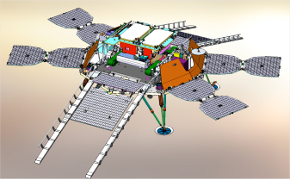ExoMars 2022 surface platform
The ExoMars 2022 mission will have two science elements that land on Mars: a European rover, Rosalind Franklin, and a Russian surface platform, Kazachok.
 |
| Sketch of the ExoMars 2022 surface platform. Credit: Roscosmos/Lavochkin/IKI |
The rover will leave the surface platform and travel across the surface of Mars to search for signs of well-preserved organic material, particularly from the early period of the planet. The surface platform, which is the responsibility of Roscosmos and the Space Research Institute of Russian Academy of Sciences (IKI), will remain stationary and will investigate the surface environment at the landing site. The set of sensors and instruments on the surface platform will operate during its nominal mission lifetime of one Earth year.
The main science priorities for the surface platform are context imaging of the landing site, long-term climate monitoring, and atmospheric investigations.
Sensors and instruments on the surface platform will also be used to study the subsurface water distribution at the landing site, to investigate the exchange of volatiles between the atmosphere and the surface, to monitor the radiation environment and compare it with measurements made with the radiation dosimeter on the FREND instrument (on the ExoMars 2016 Trace Gas Orbiter), and to carry out geophysical investigations of the planet’s internal structure.
Following a call to the European scientific community issued in March 2015, nine proposals were received and assessed. In November 2015, ESA approved the selection of six European elements. This includes two European-led instruments, and four sensor packages to be included in two Russian-led instruments.
The two European-led instruments proposed are the Lander Radioscience experiment (LaRa) and the Habitability, Brine Irradiation and Temperature package (HABIT).
LaRa will reveal details of the internal structure of Mars, and will make precise measurements of the rotation and orientation of the planet by monitoring two-way Doppler frequency shifts between the surface platform and Earth. It will also be able to detect variations in angular momentum due to the redistribution of masses, such as the migration of ice from the polar caps to the atmosphere.
HABIT will investigate the amount of water vapour in the atmosphere, daily and seasonal variations in ground and air temperatures, and the UV radiation environment.
The four European sensor packages in the two Russian-led instruments will monitor pressure and humidity, UV radiation and dust, the local magnetic field and plasma environment.
The surface platform will have a mass of 827.9kg, including a scientific payload of 45kg. The instruments are listed below.
| ExoMars 2022 Surface Science Platform: instruments | |
| Instrument | Description |
| LaRa | Lander radio-science experiment Principal Investigator: V. Dehant (Royal Observatory Belgium) |
| HABIT | Habitability, brine irradiation and temperature package Principal Investigator: F.J. Martin-Torres (Luleå University of Technology, Sweden) |
| METEO M | Meteorological package Principal Investigator: A. Lipatov (IKI, Russia) |
| METEO-P, METEO-H (part of the METEO instrument) |
Pressure and humidity sensors Principal Investigator: A.-M. Harri (Finnish Meteorological Institute, Finland) |
| RDM (part of the METEO package) |
Radiation and dust sensors Principal Investigator: I. Arruego (Instituto Nacional de Técnica Aeroespacial (INTA), Spain) |
| AMR (part of the METEO instrument) |
Anisotropic magneto-resistance sensor to measure magnetic fields Principal Investigator: M. Diaz Michelena (Instituto Nacional de Técnica Aeroespacial (INTA), Spain) |
| MAIGRET | Magnetometer Principal Investigator: A. Skalsky (IKI, Russia) |
| WAM (part of the MAIGRET instrument) |
Wave analyser module Principal Investigator: O. Santolik (Institute of Atmospheric Physics, Czech Republic) |
| TSPP | Set of cameras to characterise the landing site environment Principal Investigator: I. Polyanskiy (IKI, Russia) |
| BIP | Instrument interface and memory unit Principal Investigator: K. Anufreychik (IKI, Russia) |
| FAST | IR Fourier spectrometer to study the atmosphere Principal Investigator: O. Korablev (IKI, Russia) |
| ADRON-EM | Active neutron spectrometer and dosimeter (can work in tandem with the rover neutron detector) Principal Investigator: O. Mitrofanov (IKI, Russia) |
| M-DLS | Multi-channel Diode-Laser Spectrometer for atmospheric investigations Principal Investigator: I. Vinogradov (IKI, Russia) |
| PAT-M | Radio thermometer for soil temperatures (down to 1-m depth) Principal Investigator: D. Skulachev (IKI, Russia) |
| Dust Suite | Dust particle size, impact, and atmospheric charging instrument suite Principal Investigator: A. Zakharov (IKI, Russia) |
| SEM | Seismometer Principal Investigator: A. Manukin (IKI, Russia) |
| MGAP | Gas chromatography-mass spectrometry for atmospheric analysis Principal Investigator: M. Gerasimov (IKI, Russia) |
